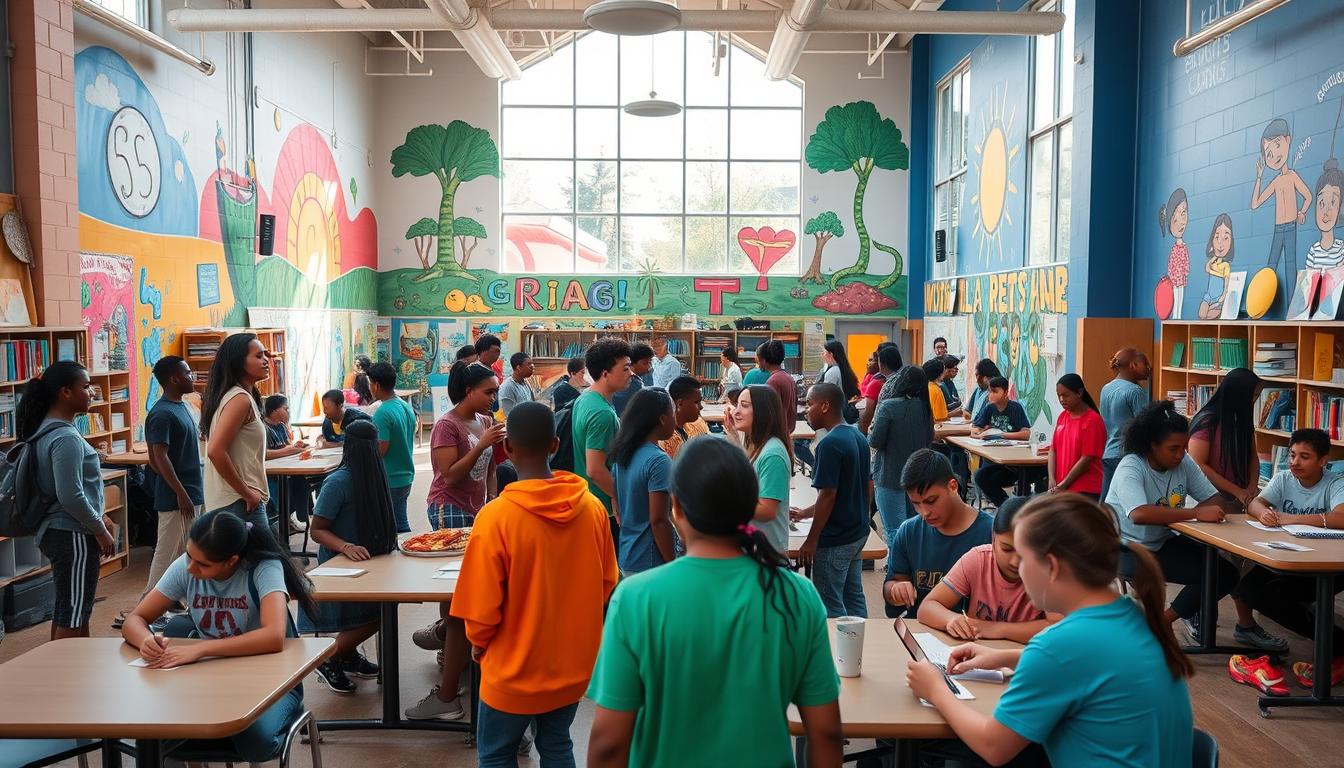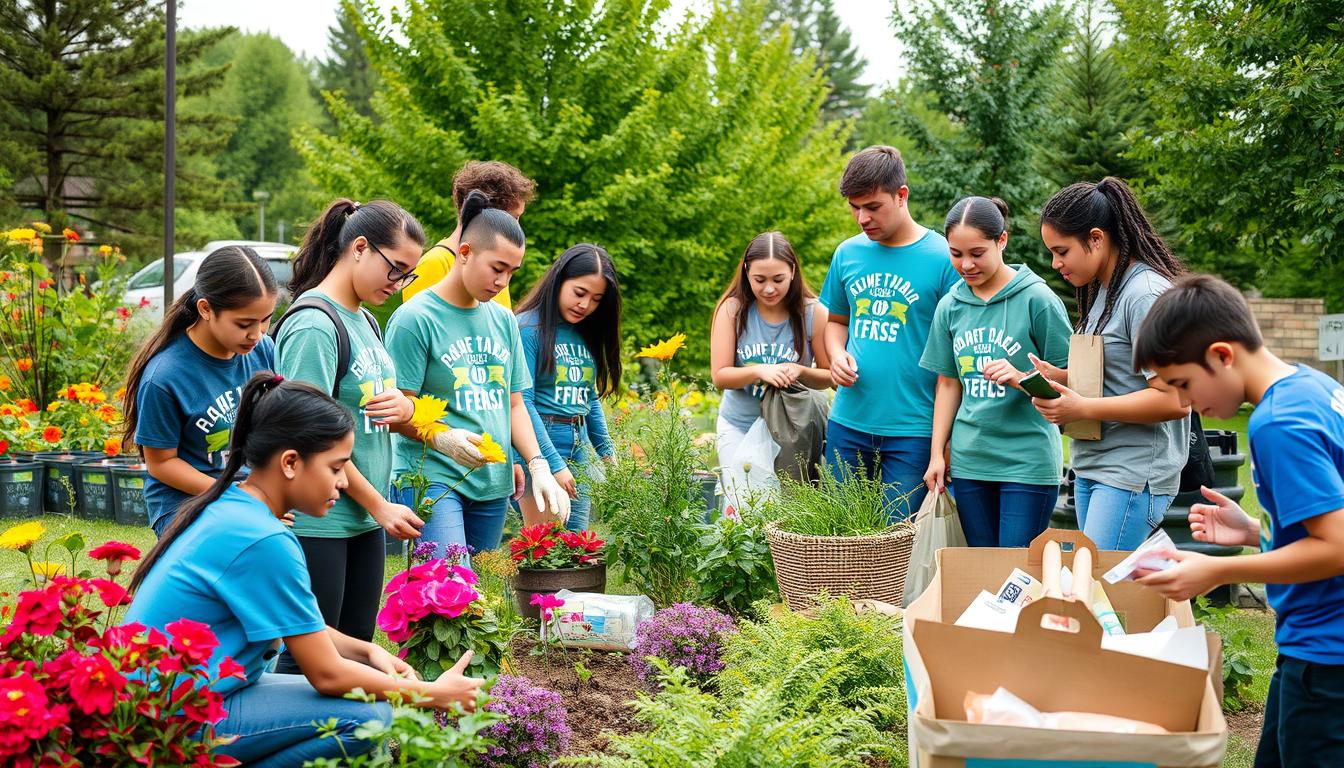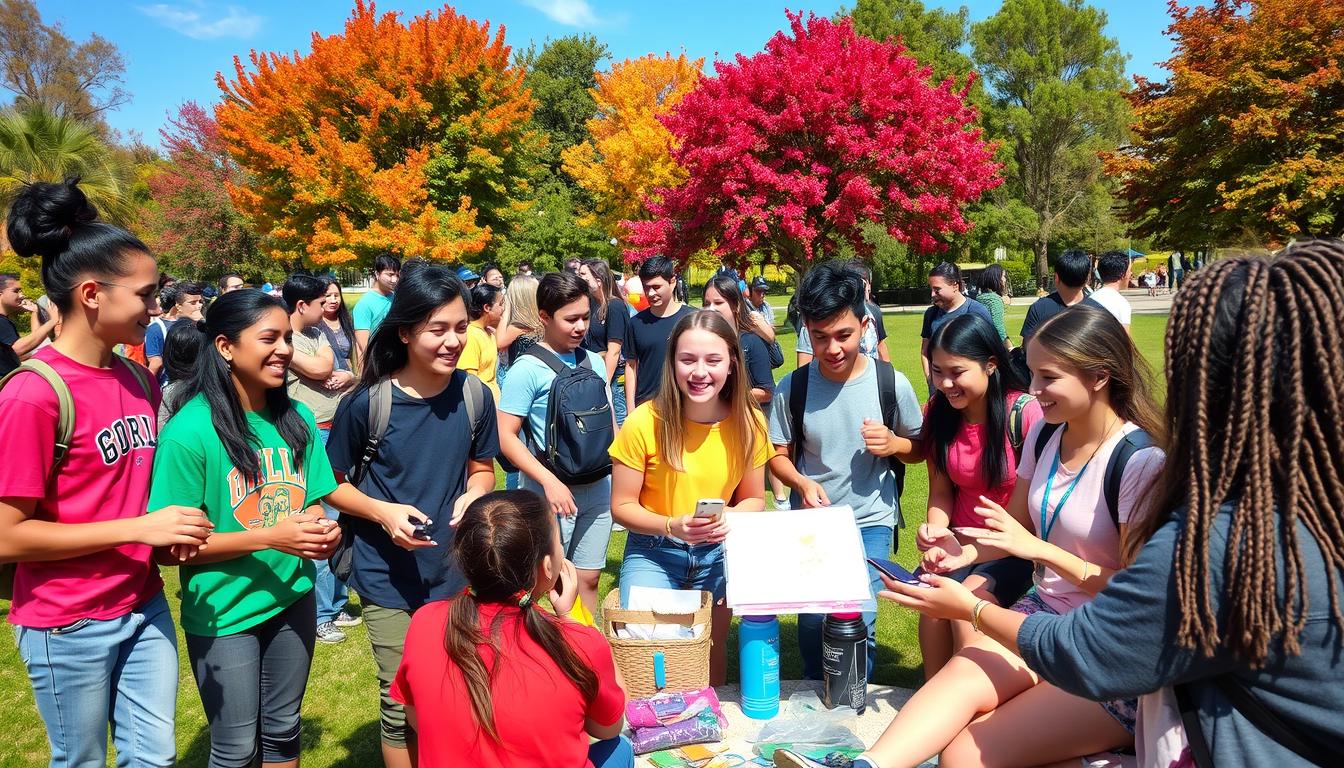Keeping a Barely Legal Delinquent Teen Busy
In today’s world, many teens seem disengaged and at-risk. It’s tough to keep them busy with good activities. But, with the right approach, we can help them grow positively. The big question is, how can we engage and empower these “barely legal delinquents” to help them grow?
Key Takeaways
- Understand the common risk factors and signs of disengagement among at-risk youth.
- Explore the benefits of structured activities that promote positive youth development.
- Discover educational engagement programs, sports, and creative arts opportunities to keep teens occupied.
- Emphasize the importance of community service, career development, and building positive peer relationships.
- Recognize the role of family involvement and professional support resources in guiding these young individuals.
Understanding Youth Development Challenges
Adolescence can be tough for many young people. They face many challenges, from risk factors to feeling disconnected. It’s important to know these challenges to help them succeed.
Common Risk Factors
Young people deal with many risks. These include unstable homes, school troubles, peer pressure, and bad behaviors. Knowing these risks helps us find who needs extra help.
Signs of Disengagement
Spotting when a young person is feeling left out is key. Look for signs like missing school, pulling away from friends, and doing poorly in school. Catching these signs early can stop them from getting worse.
Impact of Positive Intervention
Good programs can really change a young person’s life. These might include mentorship, skills classes, and community projects. They help with school, personal growth, and feeling good about oneself. By supporting these efforts, we help young people reach their goals.
| Risk Factors | Signs of Disengagement | Positive Interventions |
|---|---|---|
|
|
|
“Investing in positive interventions for at-risk youth can empower them to overcome challenges and unlock their full potential.”
Benefits of Structured Activities for Youth
Structured activities help at-risk youth grow and develop. They give a positive way to use energy and creativity. They also help build skills, make friends, and do better in school.
These activities boost self-esteem. They challenge young people and help them feel successful. This makes them more confident and able to make better choices.
Structured activities also improve social skills. Activities like team sports or community service teach teamwork and communication. These skills help them deal with life’s challenges.
Studies show these activities can also help with schoolwork. They keep young people interested in learning. They learn to manage time and stay focused.
| Benefit | Description |
|---|---|
| Enhanced Self-Esteem | Structured activities allow youth to experience success and develop a greater sense of confidence and self-worth. |
| Improved Social Skills | Group-based activities foster collaboration, communication, and the development of meaningful relationships. |
| Academic Performance Boost | Structured activities support engagement in education, time management, and discipline, leading to improved academic outcomes. |
Investing in structured activities for at-risk youth is key. It helps them grow, become socially skilled, and succeed in school.
Educational Engagement Programs
For young people facing challenges, special programs can help a lot. These programs aim to make learning fun again. They offer support and skills to help at-risk youth succeed.
Academic Support Options
These programs give important help with schoolwork. They offer tutoring, homework help, and plans just for you. This helps students feel better about school and do well.
Skill-Building Workshops
They also have workshops to teach life skills. Topics include money management, time skills, and how to get a job. These skills help youth get ready for the future.
Mentorship Programs
Mentorship is a big part of these programs. It matches young people with caring adults. These mentors offer support and share wisdom, helping youth through tough times.
These programs change lives by meeting many needs. They offer support, teach skills, and provide mentorship. This helps young people beat challenges and reach their dreams.
Sports and Physical Activities
Getting kids into sports and physical activities is great for their well-being. It helps them stay fit and learn important skills like teamwork and discipline.
Research shows that being active is good for kids’ minds and feelings. Team sports help kids learn to work together and feel confident. They also teach the value of teamwork.
- Playing sports can help kids avoid bad habits like drug use and crime.
- Physical activities give kids a healthy way to use their energy. This helps them stay out of trouble.
- Team sports help kids feel part of a group. This builds strong friendships and support.
Adding sports and activities to youth programs is a smart move. It helps kids grow strong and emotionally healthy. These programs teach kids valuable skills for life.
“Sports have the power to change the world. They have the power to inspire, the power to unite people in a way that little else does.”
– Nelson Mandela
Investing in youth sports programs and physical activity initiatives changes lives. It helps at-risk kids overcome challenges and achieve their dreams.
Creative Arts and Self-Expression
Doing creative arts is great for youth development. It helps young people express themselves and grow. Activities like music, performance, and visual arts are good for this.
Music and Performance
Music and performance programs are very helpful. They let young people show their musical talents. They also build confidence and teach teamwork and communication.
- Instrument instruction and ensemble playing
- Vocal training and choral performances
- Drama workshops and theatrical productions
Visual Arts Programs
Visual arts programs are great for self-expression. They let young people use painting, drawing, sculpture, and photography. This way, they can share their thoughts and feelings.
- Painting and drawing classes
- Ceramics and sculpture workshops
- Photography and digital art programs
By doing these creative arts activities, at-risk youth can learn a lot. They become more confident and find healthy ways to express themselves. This helps them grow and develop.
Community Service Opportunities
Getting at-risk youth into community service is a great way to teach them about social responsibility. It helps them feel connected to their community. They learn important skills, make friends, and help their neighborhoods.
There are many ways to do community service. You can clean up parks or help at charities. These actions help the community and make the youth feel proud.
Benefits of Community Service for Youth
- Develops a sense of civic duty and social responsibility
- Fosters a connection to the local community
- Builds essential life skills, such as teamwork and problem-solving
- Provides a sense of purpose and accomplishment
- Helps develop empathy and compassion towards others
By adding community service to programs for at-risk youth, we help them grow. They become active members of their communities. This helps them grow personally and feel better about themselves.
| Community Service Activity | Benefits | Potential Partners |
|---|---|---|
| Park Cleanup | Environmental awareness, teamwork, physical activity | Local parks department, environmental organizations |
| Food Bank Volunteering | Compassion, understanding of food insecurity, practical skills | Food banks, soup kitchens, local charities |
| Visiting Senior Homes | Intergenerational connections, empathy, communication skills | Assisted living facilities, senior centers |
“Engaging in community service helps young people develop a sense of responsibility and empowerment that can positively impact their lives and the lives of those around them.”
By supporting youth volunteering and community engagement, we help at-risk youth. We also make our community better. This promotes a culture of social responsibility and civic participation.
Career Development and Job Training
Supporting at-risk youth includes career development and job training. These help them get ready for jobs. Communities can help young people learn skills for their future careers.
Vocational Programs
Vocational programs teach hands-on skills in many areas. This includes car repair, building, cooking, beauty, and computer tech. These programs let youth learn and grow, making them more employable.
Internship Opportunities
Internships give youth real work experience. They work with schools, groups, and businesses. This helps them build their resume and learn in a real setting.
| Benefits of Youth Career Development | Impact of Job Training Programs |
|---|---|
|
|
Investing in youth career development and job training helps at-risk youth. It gives them skills and confidence. This leads to a better future for them.
Building Positive Peer Relationships
Helping at-risk youth make friends is key. It helps them learn important social skills. It also gives them a group to support them.
Peer Support and Skill-Building
Being part of groups, like sports or arts, helps them work together. They learn to talk and share ideas. This builds social skills and a feeling of peer support.
Mentorship and Role Models
Having mentors is very important. They are like guides for at-risk youth. Mentors help them deal with tough times and teach them about good relationships.
| Strategies for Building Positive Peer Relationships | Benefits |
|---|---|
| Structured group activities | Develop social skills, foster peer support |
| Mentorship programs | Provide positive role models, nurture healthy relationships |
| Conflict resolution training | Equip youth with skills to manage interpersonal challenges |
| Inclusive social events | Encourage meaningful connections and a sense of community |
Using these methods helps at-risk youth make strong, positive friendships. It also helps them learn to deal with social situations. This way, they can grow and succeed in the future.
Family Involvement Strategies
Getting families involved is key to helping at-risk youth. Parents and guardians are crucial in a child’s life. They offer love, guidance, and stability. This helps youth programs meet each child’s needs better.
One good way is to encourage open communication between families and program staff. Regular talks and updates help parents feel connected. Also, parental engagement activities, like family workshops, help parents support their child’s growth.
Another important step is to connect families with community resources. This could be mental health services, financial help, or educational tools. It strengthens the family and helps youth thrive in a stable environment.
| Strategy | Benefits |
|---|---|
| Open Communication | Fosters collaboration, empowers parents, and ensures a shared understanding of progress and goals. |
| Community Resource Connection | Addresses holistic family needs, strengthens support systems, and creates a more stable environment for youth. |
| Inclusive Programming | Welcomes family participation, celebrates cultural diversity, and reinforces the importance of family involvement. |
By using these strategies, youth programs can build a supportive environment. This helps both young people and their families overcome challenges and reach their goals.
Professional Support Resources
Helping young people grow can be tough. But, many professional resources are here to help. They offer youth counseling, mental health resources, and support programs. These can really help at-risk youth.
Youth counseling is very important. Counselors know how to help teens. They give a safe place for teens to talk about their feelings and problems. Counselors help teens learn to cope and grow strong.
There are also many mental health resources for teens. This includes hotlines, groups, therapy, and more. These help teens deal with their mental health issues.
Many places have support programs for teens. These programs help with school, jobs, community service, and more. Teens can learn new skills and feel part of something.
Using these support resources can change a teen’s life. They get the help they need to succeed and grow.
Conclusion
Providing youth with fun and helpful activities is very important. It helps them grow and feel good about themselves. By giving them chances to learn and be involved, we help them reach their dreams.
Things like school programs, sports, arts, and helping others are great. They teach important skills and help kids make friends. By supporting our youth, we help them become strong and caring people.
In the end, helping our youth is key to a better future. By giving them good opportunities, we make tomorrow brighter. Let’s keep working to help our young people grow and make our world a better place.
FAQ
What are some constructive activities to keep a teen busy?
It’s good to keep teens busy with positive things. They can try educational programs, sports, and arts. Community service and career development are also great options.
How can I support a teen who is disengaged or at-risk?
First, find out what’s making them disengaged. Then, help them with activities and programs. Educational support and workshops are key. Mentorship is also very important.
What are the benefits of structured activities for youth?
Structured activities help teens feel better about themselves. They learn social skills and do better in school. These activities also help them grow and make friends.
What types of educational engagement programs are available?
There are many programs for at-risk youth. They offer academic support, workshops, and mentorship. These help teens do well in school and develop skills.
How can sports and physical activities benefit at-risk youth?
Sports and activities teach teamwork and discipline. They help teens grow and interact with others. These activities are also good for their health.
What role can creative arts play in youth development?
Creative arts like music and visual arts help teens express themselves. They build confidence and provide a positive outlet. These activities encourage creativity.
Why is community service important for at-risk youth?
Community service teaches teens about responsibility. It helps them understand their role in society. It also gives them a chance to make a difference.
What career development and job training options are available for at-risk youth?
There are programs for vocational skills and internships. They prepare teens for jobs and help them become independent. These programs support their transition to work.
How can at-risk youth build positive peer relationships?
Help teens develop social skills and join group activities. Create a supportive environment. This encourages healthy interactions and friendships.
What role can families play in supporting at-risk youth?
Families are key in supporting at-risk teens. Get involved in their activities and offer resources. Open communication is also important for their well-being.
What professional support resources are available for at-risk youth?
At-risk teens have access to counseling and mental health services. These resources help them face challenges and grow. They provide the support they need.




